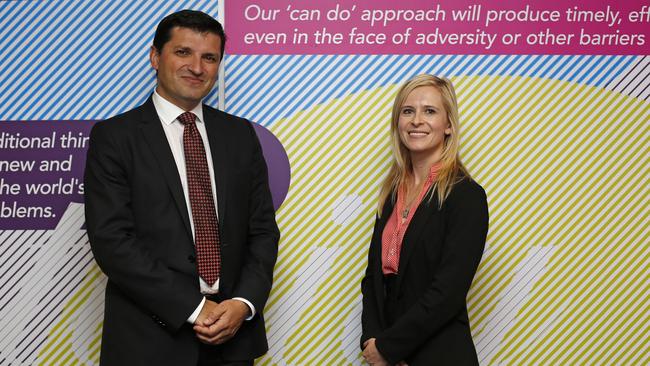Young researchers get The George Institute for Global Health backing
AS funding for research dries up, The George Institute has stepped up efforts to mentor young researchers and help them find a foothold.

MEDICAL research is a vocation for many, says the executive director of The George Institute for Global Health, but it is becoming increasingly difficult to access grants to help early career researchers get funding.
Professor Vlado Perkovic, a nephrologist by trade, has seen what is affectionately known as The George grow 10-fold over the past decade, and knows what a fulfilling career research can be.
“Working in research is incredibly rewarding and valuable to us as a country,” Perkovic says.
“The money that’s spent on research delivers a huge benefit to Australia, both economically and for our health and wellbeing. It’s a wonderful opportunity to make a contribution to our society and also globally.”
As the government funding channelled through the National Health and Medical Research Council tightens and grants become more difficult to obtain, Perkovic says young career researchers are facing a battle for support.
It has not helped that the CSIRO has announced plans to cut more than $100 million from its budget, which could mean up to 700 job cuts over this financial year. “It is quite frightening for some people, particularly for young women who are planning their career and family, because many of the funding streams are driven by people’s achievements,” Perkovic says.
“While there are allowances made for people who have time away from work, including women who have children, these women seem to be under-represented, particularly in senior positions.”
Australian of the Year candidate Adele Green, an epidemiologist who led research that established the link between sunscreen use and melanoma, said earlier this year that it can be very difficult for young women to establish a career in research.
“We should have more acceptance that women are naturally talented scientists with their curiosity and their ability to intuit,” Green said last month.
“It’s still a challenge for universities and the funding boards to recognise that you need a lot of dedicated time for bringing up children that doesn’t detract from career progression. It’s still ingrained for some of the full-time scientists who’ve taken time out of their careers, and seeing someone who’s older who doesn’t have the productivity of someone who hasn’t, it’s still quite a challenge.”
She has also been a mentor to dozens of young scientists throughout her career and sees the significance of helping younger researchers get a foothold.
Perkovic says The George places a great emphasis on mentoring young researchers. The institute considers the need to retain the nation’s top minds as critical, and while many are struggling to undertake their work without the promise of long-term funding, mentoring is one way they can help. “We’ve spent a lot of time and energy on how we can best support the young minds that are going to be the future, and we’ve developed a program to help them be successful,” he says.
As well as mentoring, there is discretionary funding when they are confident a young researcher will be able to make a significant research contribution, and internal fellowships to make up funding gaps.
Perkovic says despite concerns not enough high school leavers are being attracted to study sciences, there is no shortage of high quality researchers looking for positions and many are turned away.
There are 500 staff across The George Institute’s offices and facilities in Sydney, India, China and Britain. Despite expanding more than tenfold since the institute opened 15 years ago, Perkovic says if the funding permits and commercial and academic partnerships can be found they will expand further.
It can be difficult to find additional funding, and Perkovic says opportunities include developing new ways of improving health and nutrition for companies, through global partnerships, philanthropy and access to grants.
Perkovic says federal government research increased in the 1990s and early 2000s before stagnating. He says the proposed $20 billion Medical Research Future Fund is critical for the nation’s research future, given it will ensure quality research is undertaken to improve the health and wellbeing of the population and contribute to the economy.
“We need to catch up and be leaders again, we don’t want to run the risk of falling further behind.”
While the National Health and Medical Research Council funding stream has always been available, Perkovic says more researchers are applying than ever because of the dearth of grants elsewhere.
“For project grants a decade ago one third would have been funded by the NHMRC, it’s now down to one in seven,” he says.
“The vast majority are not being supported. It’s still only the minority who are being given funding. I don’t think it’s the number of grants shrinking, but the number of people applying for these roles is growing, partly because other funding has dried up.
“People who have traditionally had funding from elsewhere are turning to the NHMRC and it’s making it difficult for early career researchers.” Nutritionist Lizzy Dunford, 31, is the Global Database Manager at The George. She had been turned down twice for NHMRC grants before finding success. The global food policy expert has presented at 42 national and international conferences but has still found it difficult, despite managing a database of more than 500,000 food brand samples and monitoring their sugar, fat and salt contents.
“Once I got into The George, when you’re a young researcher you’re encouraged to do a PhD,” Dunford says.
“It’s not just doing research and being able to effect change. You can talk about what’s happening to the world’s food supply.”
Dunford has also been instrumental in developing the international FoodSwitch app, which helps people make smarter food choices by scanning barcodes and interpreting nutritional information.


